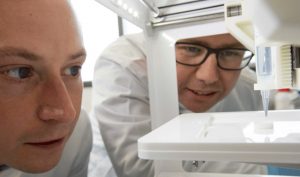Biotechnology and innovation open new horizons for corneal transplants
Researchers at the British University of Newcastle have succeeded in an incredible feat: 3D printing a human cornea.
Prof. Che Connon and Dr. Steve Swioklo and Dr. Abigail Isaacson presented the results of their research work in a study published in the journal Experimental Eye Research describing the procedure that led to this interesting result.
To print the artificial cornea, they used a bio-ink made from a mix of human stem cells from a healthy donor cornea, supplemented with alginate (a gel derived from algae) and collagen.
At the time of printing, bio-ink was emitted from the 3D printer, drawing concentric circles that took the shape of a human corneal epithelium in about 10 minutes.

Prof. Che Connon stated that this particular bio-ink, based on alginate and collagen, is able to keep stem cells alive during the process required to produce a material that is rigid enough to keep its shape, but soft enough to come out of the nozzles of the 3D printer.
By taking exact measurements of the patient's cornea with a bioscan, it is possible to print a corneal epithelium that exactly matches the particular specifications of that particular eye, in shape and size.
This interesting technological innovation could help to meet the need for corneal tissue for implantation, which still cannot be adequately met through donations and is therefore an 'unmet clinical need'.
The WHO (World Health Organisation) estimates that there are approximately 10 million patients worldwide who would need a corneal transplant to prevent corneal blindness caused by trachoma infection, to which must be added another 4.9 million people who suffer impaired visual function as a result of corneal injuries, whether from burns, lacerations, abrasions or the effects of eye diseases.
The 3-D cornea still requires further laboratory testing, but the technique could find regular use in clinical practice in an estimated timeframe of the order of five years and thus contribute to meeting the growing demand for corneal transplants
References
Isaacson A, Swioklo S, Connon CJ. 3D bioprinting of a corneal stroma equivalent. Exp Eye Res. 2018 May 30;173:188-193.
Dr. Carmelo Chines
Direttore responsabile
